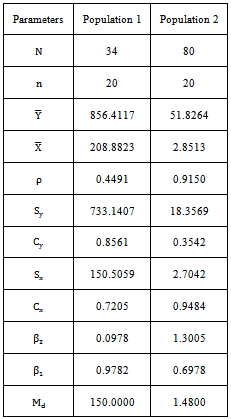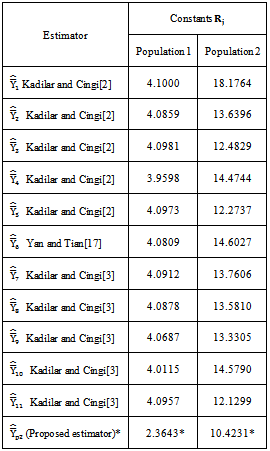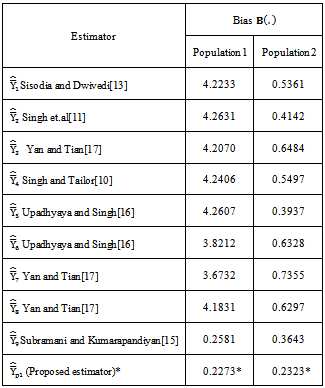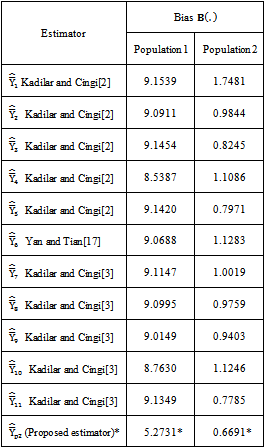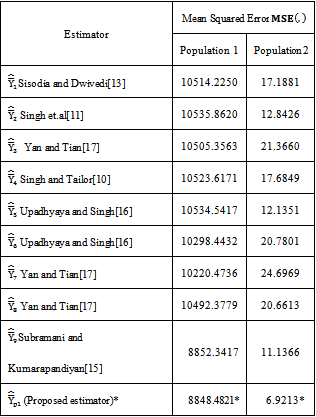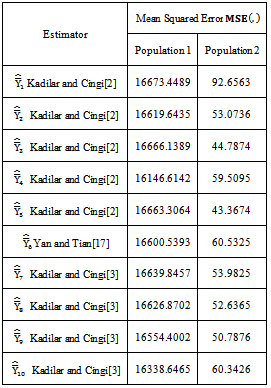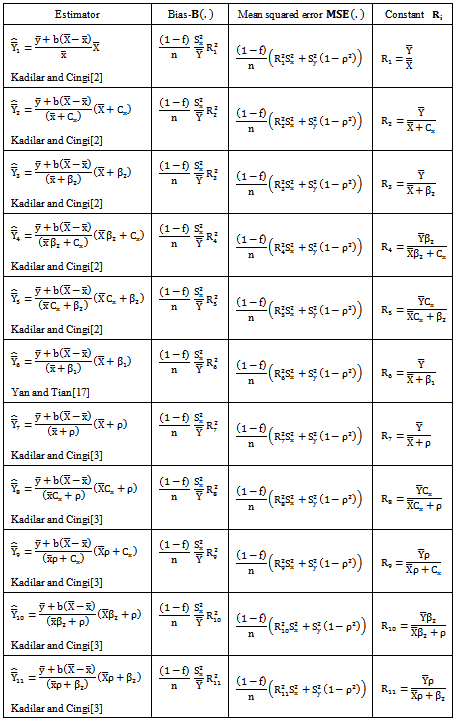-
Paper Information
- Next Paper
- Paper Submission
-
Journal Information
- About This Journal
- Editorial Board
- Current Issue
- Archive
- Author Guidelines
- Contact Us
American Journal of Mathematics and Statistics
p-ISSN: 2162-948X e-ISSN: 2162-8475
2012; 2(5): 101-107
doi: 10.5923/j.ajms.20120205.01
Estimation of Population Mean Using Known Median and Co-Efficent of Skewness
J. Subramani , G. Kumarapandiyan
Department of Statistics, Pondicherry University, R V Nagar, Kalapet Puducherry, 605014, India
Correspondence to: J. Subramani , Department of Statistics, Pondicherry University, R V Nagar, Kalapet Puducherry, 605014, India.
| Email: |  |
Copyright © 2012 Scientific & Academic Publishing. All Rights Reserved.
The present paper deals with two modified ratio estimators for estimation of population mean of the study variable using the linear combination of the known population values of the Median and the Co-efficient of Skewness of the auxiliary variable. The biases and the mean squared errors of the proposed estimators are derived and are compared with that of existing modified ratio estimators for certain natural populations. Further we have also derived the conditions for which the proposed estimators perform better than the existing modified ratio estimators. From the empirical study it is also observed that the proposed modified ratio estimators perform better than the existing modified ratio estimators.
Keywords: Bias, Mean Squared Error, Modified Ratio Estimators, Simple Random Sampling
Article Outline
1. Introduction
- The sampling theory describes a wide variety of techniques for using auxiliary information to obtain more efficient estimators like Ratio, Product and Regression estimators for the estimation of the mean of the study variable Y. Ratio estimators, improves the precision of estimate of the population mean of a study variable by using prior information on auxiliary variable X which is positively correlated with the study variable Y. Over the years the ratio method of estimation has been extensively used because of its intuitive appeal and the computational simplicity. When the population parameters of the auxiliary variable X such as Population Mean, Co-efficient of Variation, Co-efficient of Kurtosis, Co-efficient of Skewness, Median are known, a number of modified estimators such as modified ratio estimators, modified product estimators and modified linear regression estimators are proposed in the literature. Before discussing further about the modified ratio estimators and the proposed modified ratio estimators the notations to be used in this paper are described below:• N - Population size• n -Sample size• f = n/N, Sampling fraction• Y - Study variable• X - Auxiliary variable•
 Population means•
Population means•  Sample means•
Sample means•  Population standard deviations•
Population standard deviations•  Co-efficient of variations•
Co-efficient of variations•  Co-efficient of correlation•
Co-efficient of correlation•  , Co-efficient of skewness of the auxiliary variable•
, Co-efficient of skewness of the auxiliary variable• , Co-efficient of kurtosis of the auxiliary variable•
, Co-efficient of kurtosis of the auxiliary variable•  Median of the auxiliary variable•
Median of the auxiliary variable•  Bias of the estimator•
Bias of the estimator•  Mean squared error of the estimator•
Mean squared error of the estimator•  Existing (proposed) modified ratio estimator of
Existing (proposed) modified ratio estimator of  The Ratio estimator for estimating the population mean
The Ratio estimator for estimating the population mean  of the study variable Y is defined as
of the study variable Y is defined as  | (1) |
 and their linear combinations. Recently Yan and Tian[17] have used Coefficient of Skewness for the estimation of population meanHowever, it seems, no attempt is made to use the linear combination of known values of the Median and Co-efficient of Skewness of the auxiliary variable to improve the ratio estimator. The points discussed above have motivated us to introduce two modified ratio estimators using the linear combination of the known values of Median and Co-efficient of Skewness of the auxiliary variable. When the population median and coefficient of skewness are unknown the proposed estimators can be modified using their respective estimates i.e sample median, and sample coefficient of skewness obtained from the sample. The proposed estimators can be applicable in the following practical situation. 1. A national park is partitioned into N units.• Y = the number of animals in the ith unit • X = the size of the ith unit 2. A certain city has N bookstores.• Y = the sales of a given book title at the ith bookstore• X = the size of the ith bookstore3. A forest that has N trees.• Y = the volume of the tree• X = the diameter of the tree
and their linear combinations. Recently Yan and Tian[17] have used Coefficient of Skewness for the estimation of population meanHowever, it seems, no attempt is made to use the linear combination of known values of the Median and Co-efficient of Skewness of the auxiliary variable to improve the ratio estimator. The points discussed above have motivated us to introduce two modified ratio estimators using the linear combination of the known values of Median and Co-efficient of Skewness of the auxiliary variable. When the population median and coefficient of skewness are unknown the proposed estimators can be modified using their respective estimates i.e sample median, and sample coefficient of skewness obtained from the sample. The proposed estimators can be applicable in the following practical situation. 1. A national park is partitioned into N units.• Y = the number of animals in the ith unit • X = the size of the ith unit 2. A certain city has N bookstores.• Y = the sales of a given book title at the ith bookstore• X = the size of the ith bookstore3. A forest that has N trees.• Y = the volume of the tree• X = the diameter of the tree2. Proposed Modified Ratio Estimators
- In this section, we have suggested two modified ratio estimators using the linear combination of Median and Co-efficient of Skewness of the auxiliary variable. The proposed modified ratio estimators for estimating the population mean
 together with the first degree of approximation, the biases and mean squared errors and the constants are given below:
together with the first degree of approximation, the biases and mean squared errors and the constants are given below: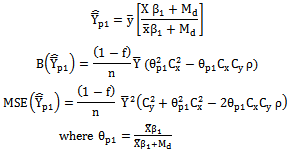 | (2) |
 | (3) |
3. Efficiency Comparison
- For want of space; for the sake of convenience to the readers and for the ease of comparisons, the modified ratio estimators given in Table 1, Table 2 are represented into two classes as given below. Further it is to be noted that the proposed estimator
 is compared with the modified ratio estimators listed in Class 1 whereas the proposed estimator
is compared with the modified ratio estimators listed in Class 1 whereas the proposed estimator  is compared with the modified ratio estimators listed in Class 2.Class 1:The biases, the mean squared errors and the constants of the modified ratio type estimators
is compared with the modified ratio estimators listed in Class 2.Class 1:The biases, the mean squared errors and the constants of the modified ratio type estimators  listed in the Table 1 are represented in a single class (say, Class 1), which will be very much useful for comparing with that of proposed modified ratio estimators and are given below:
listed in the Table 1 are represented in a single class (say, Class 1), which will be very much useful for comparing with that of proposed modified ratio estimators and are given below: | (4) |
 Class 2:The biases, the mean squared errors and the constants of the 11 modified ratio estimators
Class 2:The biases, the mean squared errors and the constants of the 11 modified ratio estimators  listed in the Table 2 are represented in a single class (say, Class 2), which will be very much useful for comparing with that of proposed modified ratio estimators and are given below:
listed in the Table 2 are represented in a single class (say, Class 2), which will be very much useful for comparing with that of proposed modified ratio estimators and are given below: | (5) |
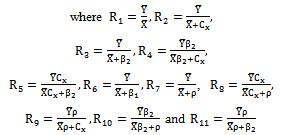 As derived earlier in section 2, the biases, the mean squared errors and the constants of two proposed modified ratio estimators are given below:
As derived earlier in section 2, the biases, the mean squared errors and the constants of two proposed modified ratio estimators are given below: | (6) |
 | (7) |
 is more efficient than the existing modified ratio estimators given in Class 1,
is more efficient than the existing modified ratio estimators given in Class 1,  and are given below.From the expressions given in (5) and (7) we have derived the conditions for which the proposed estimator
and are given below.From the expressions given in (5) and (7) we have derived the conditions for which the proposed estimator  is more efficient than the existing modified ratio estimators given in Class 2,
is more efficient than the existing modified ratio estimators given in Class 2,  and are given below:
and are given below: | (9) |
4. Numerical Study
|
|
|
|
|
|
 is less than the biases of the existing modified ratio estimators
is less than the biases of the existing modified ratio estimators  given in Class 1 and the bias of the proposed modified ratio estimator
given in Class 1 and the bias of the proposed modified ratio estimator  is less than the biases of the existing modified ratio estimators
is less than the biases of the existing modified ratio estimators  given in Class 2. Similarly from the values of Table 8 and Table 9, it is observed that the mean squared error of the proposed modified ratio estimator
given in Class 2. Similarly from the values of Table 8 and Table 9, it is observed that the mean squared error of the proposed modified ratio estimator  is less than the mean squared errors of the existing modified ratio estimators
is less than the mean squared errors of the existing modified ratio estimators  given in Class 1 and the mean squared error of the proposed modified ratio estimator
given in Class 1 and the mean squared error of the proposed modified ratio estimator  is less than the mean squared errors of the existing modified ratio estimators
is less than the mean squared errors of the existing modified ratio estimators  given in Class 2.
given in Class 2.
|
5. Conclusions
- In this paper we have proposed two modified ratio estimators using linear combination of Median and Co-efficient of Skewness of the auxiliary variable. The biases and mean squared errors of the proposed estimators are obtained and compared with that of existing modified ratio estimators. Further we have derived the conditions for which the proposed estimators are more efficient than the existing modified ratio estimators. We have also assessed the performances of the proposed estimators for some known populations and observed that the biases and mean squared errors of the proposed estimators are less than the biases and mean squared errors of the existing modified ratio estimators. Hence we strongly recommend the proposed modified estimators over the existing modified ratio estimators for the use of practical applications.
ACKNOWLEDGEMENTS
- The authors are thankful to the referees for their constructive comments. The second author wishes to thank the Vice Chancellor, Pondicherry University and other University authorities for the financial assistance to carry out this research work through the University Fellowship.
APPENDIX
|
|
 Abstract
Abstract Reference
Reference Full-Text PDF
Full-Text PDF Full-Text HTML
Full-Text HTML